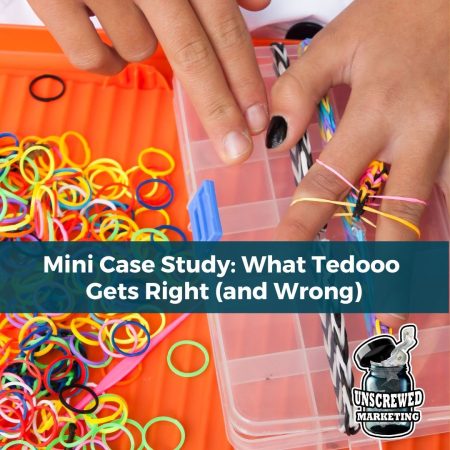- +1 512-591-8295
- [email protected]
- Mon - Fri: 9:00 - 16:00
- +1 512-591-8295
- [email protected]
- Mon - Fri: 9:00 - 16:00
Use code MOM50 at checkout thru Mother’s Day to get 50% off any gift card for marketing services

Unscrewed Marketing Mini Case Study
Here’s what Tedooo gets right—and wrong—about viral storytelling, and how to apply the lessons to your own brand without sounding fake.
Let’s set the scene.
You’re scrolling. A post starts with, “I didn’t expect to cry over a spoon.” And has an eye-catching photo or one that stirs emotion.
You pause.
It feels like a raw journal entry. A tiny moment.
By the end, you’re looking at a mention to a handmade kitchen set on Tedooo. And you’re probably not even mad about it.
That’s the magic Tedooo’s social strategy is playing with right now: they’re using emotion—storytelling, grief, nostalgia, healing—as the delivery system for commerce. And it’s working.
But also?
Some of it feels fake as hell. Like someone wrote trauma fanfiction just to sell you a candle.
So here’s what’s actually happening, what they’re doing well, what they’re absolutely not—and how you can pull off this kind of content without grossing out your audience.
Tedooo is a social marketplace app that connects handmade creators with buyers, sort of like Etsy back when Etsy still gave a damn about being handmade.
Except it’s not just a store. It’s part craft community, part inspo feed, part commerce engine. They’ve got groups, free SVGs and patterns, an AI design tool, and a ton of soft-sell creator content floating around TikTok and Instagram.
That last part—the storytelling content—is where things get interesting.
Let’s take a look at some of their posts, which can usually be found in groups related to crafting. (Click on one to open it for easier viewing.)
The top-performing content related to Tedooo doesn’t read like an ad. It’s not “Here’s why this notebook is amazing.”
Instead, it’s something more like this:
“After my divorce, I couldn’t write for months. But last week I opened a journal from a random order and… I started again.”
That’s not a product post. That’s a story. The notebook is a supporting character. The real hook is the feeling.
These posts work because:
And here’s the thing: it’s smart. It’s built to bypass resistance. You’re not selling—you’re resonating.
Except when you’re not.
Let’s talk about the part where Tedooo’s strategy feels… off.
Because for every genuinely touching post, there’s one that feels like a Mad Lib of emotional keywords glued to a random object:
“Grief. Healing. Grandma’s death. Handmade pillow.”
😬
When you fake vulnerability, people know. The internet has been sold to for too long. Your audience can smell a performative overshare from six scrolls away.
The worst offenders hit that uncanny valley where you’re not sure if someone’s opening up or trying to manipulate you. And that’s where this strategy starts to backfire.
The big issue? Inauthenticity packaged as intimacy.
If the product isn’t naturally part of the story…
If the story’s only job is to sell the product…
If the post is using emotional trauma as a “hook” just to drop a link?
That’s not storytelling. That’s a con job with better lighting.
Absolutely! But only if you know how to do it without being a creep.
You want emotionally resonant content? You want people to feel something and then buy?
You need to start with an actual story. And you need to understand the difference between authenticity and what looks like authenticity.
That’s where the HUMAN Framework comes in.
This is how we build brand content that’s emotional without being manipulative, powerful without being pushy.
| H — Hook with an emotional truth | Start with something real. Something that makes someone stop scrolling because it hits. |
| U — Uncover the feeling | Show what the moment meant. Let us in. But don’t force it—this part has to be true. |
| M — Merge story + solution | The product enters naturally. Not as a twist. Not as a stretch. Just… part of the journey. |
| A — Anchor it in detail | Give it a smell, a texture, a sound. People feel moments when you make them specific. |
| N — Nudge to next step | Mention the product softly. A tag. A link. A wink. No pitchforks. Let the story do the work. |
Tedooo’s best posts? Beautiful little snapshots of humanity, quietly connected to a product.
Their worst? Emotional bait with a coupon code at the end.
If you’re going to use story to sell—and you should—you need to treat it like what it is: a trust exchange. Because when people feel tricked, they bounce. But when they feel seen, they buy.
Enroll in the Viral Threads course and unlock the strategies behind high-engagement posts.
As a bonus, you’ll receive FREE access to the Viral Threads GPT—my custom AI tool designed to help you craft standout content. Normally priced at $27, it’s yours at no extra cost when you take the course.
Let the pros handle your social media.
This website uses cookies to ensure you get the best experience on our website. By continuing to use the website, you agree to our use of cookies. We do not share or sell your information. More info